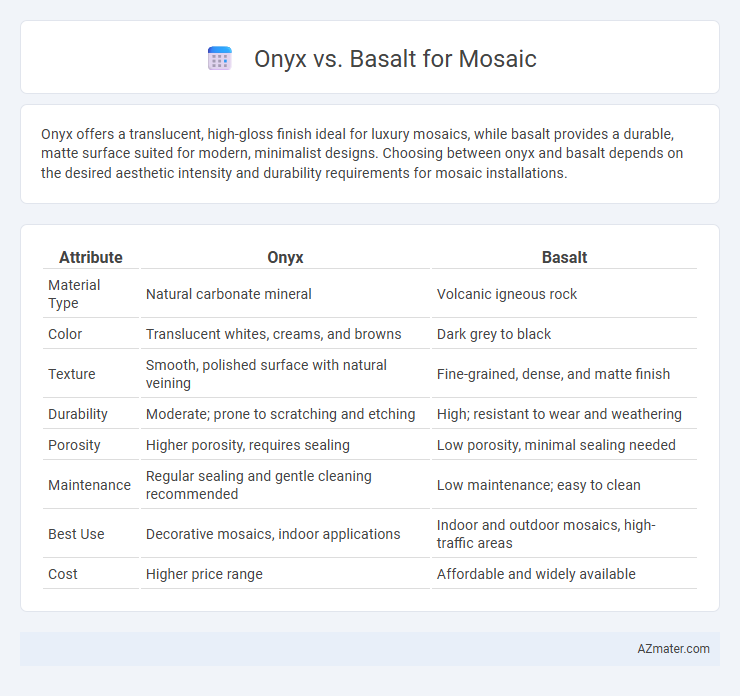Onyx offers a translucent, high-gloss finish ideal for luxury mosaics, while basalt provides a durable, matte surface suited for modern, minimalist designs. Choosing between onyx and basalt depends on the desired aesthetic intensity and durability requirements for mosaic installations.
Table of Comparison
| Attribute | Onyx | Basalt |
|---|---|---|
| Material Type | Natural carbonate mineral | Volcanic igneous rock |
| Color | Translucent whites, creams, and browns | Dark grey to black |
| Texture | Smooth, polished surface with natural veining | Fine-grained, dense, and matte finish |
| Durability | Moderate; prone to scratching and etching | High; resistant to wear and weathering |
| Porosity | Higher porosity, requires sealing | Low porosity, minimal sealing needed |
| Maintenance | Regular sealing and gentle cleaning recommended | Low maintenance; easy to clean |
| Best Use | Decorative mosaics, indoor applications | Indoor and outdoor mosaics, high-traffic areas |
| Cost | Higher price range | Affordable and widely available |
Introduction to Onyx and Basalt Mosaics
Onyx mosaics showcase translucent beauty with rich, swirling patterns created by layered calcite. Basalt mosaics feature dense, fine-grained volcanic rock known for durability and deep, matte black coloration. Both materials offer unique textures and aesthetic qualities, making them popular choices for intricate mosaic art and architectural designs.
Formation and Origin of Onyx and Basalt
Onyx is a form of chalcedony, composed of layered silica minerals formed through the slow deposition of silica-rich solutions in cold water environments, often within caves. Basalt originates from rapidly cooled lava flows, consisting mainly of fine-grained volcanic rock formed at the Earth's surface from magma. The contrasting formation processes highlight Onyx's sedimentary mineral layering versus Basalt's igneous volcanic origin, influencing their distinct appearances in mosaics.
Physical Properties: Strength and Durability
Onyx offers a softer texture with a Mohs hardness of 3, making it less resistant to scratches and impacts compared to basalt, which has a hardness of 6-7 and superior durability. Basalt's dense, volcanic origin results in exceptional strength and resistance to wear, ideal for high-traffic mosaic installations. While onyx provides unique translucency and aesthetic appeal, basalt ensures long-term structural integrity and maintenance ease in mosaic applications.
Aesthetic Differences: Color and Texture
Onyx mosaics feature a translucent quality with vibrant color variations ranging from warm amber to deep honey tones, offering a glowing and luxurious appearance. Basalt mosaics present a matte finish with uniform dark gray to black hues, providing a sleek and modern aesthetic ideal for minimalist designs. The texture of onyx is smooth and polished, enhancing its reflective properties, while basalt exhibits a slightly rough, natural stone texture that emphasizes durability and subtle sophistication.
Suitability for Indoor vs Outdoor Applications
Onyx is best suited for indoor mosaic applications due to its translucent quality and sensitivity to weathering, making it vulnerable to outdoor conditions such as moisture and UV exposure. Basalt, with its high density, durability, and resistance to heat and abrasion, offers superior performance for outdoor mosaics exposed to varying temperatures and harsh environmental elements. Choosing the appropriate material depends on balancing aesthetic preferences with functional requirements related to the installation environment.
Maintenance and Cleaning Requirements
Onyx mosaics require gentle cleaning with pH-neutral cleaners and avoid abrasive materials due to their delicate, porous nature that can easily etch or stain. Basalt mosaics are more durable and resistant to scratches and stains, allowing for more straightforward maintenance with regular mild soap and water without special precautions. Both materials benefit from periodic sealing to preserve their appearance, but basalt typically demands less frequent sealing compared to onyx.
Cost and Availability Comparison
Onyx offers a luxurious, translucent appearance but comes at a higher price point and limited availability compared to basalt. Basalt is a more affordable, durable option with widespread availability, making it ideal for budget-conscious mosaic projects. Cost efficiency and frequent supply make basalt a practical choice, whereas onyx suits high-end designs requiring unique aesthetics.
Design Versatility and Style Options
Onyx offers exceptional translucency and vibrant color variations, making it ideal for intricate mosaic designs that emphasize light play and luxury. Basalt provides a rich, matte texture with earthy tones, delivering durability and a modern, understated aesthetic suited for minimalist and industrial styles. Both materials enhance mosaic art but cater to different design preferences--onyx for bold, luminous patterns and basalt for subtle, textured compositions.
Eco-Friendliness and Sustainability
Onyx and basalt offer distinct eco-friendly advantages for mosaics, with basalt being a natural volcanic rock known for its durability and low environmental impact due to minimal processing requirements. Onyx, a form of quartz, involves more intensive extraction and refinement processes, potentially increasing its carbon footprint compared to basalt. Choosing basalt mosaics supports sustainability through its abundant availability and reduced energy consumption during production, aligning with green building standards.
Choosing the Right Stone for Your Mosaic Project
Onyx offers vibrant, translucent colors that create luxurious, eye-catching mosaics, while basalt provides durability and a natural, matte finish ideal for high-traffic areas. Choosing the right stone depends on your project's aesthetic goals and functional needs; onyx suits decorative, low-wear surfaces, whereas basalt excels in strength and weather resistance. Consider factors like maintenance, light exposure, and intended use to select the perfect stone for a lasting mosaic design.

Infographic: Onyx vs Basalt for Mosaic
 azmater.com
azmater.com